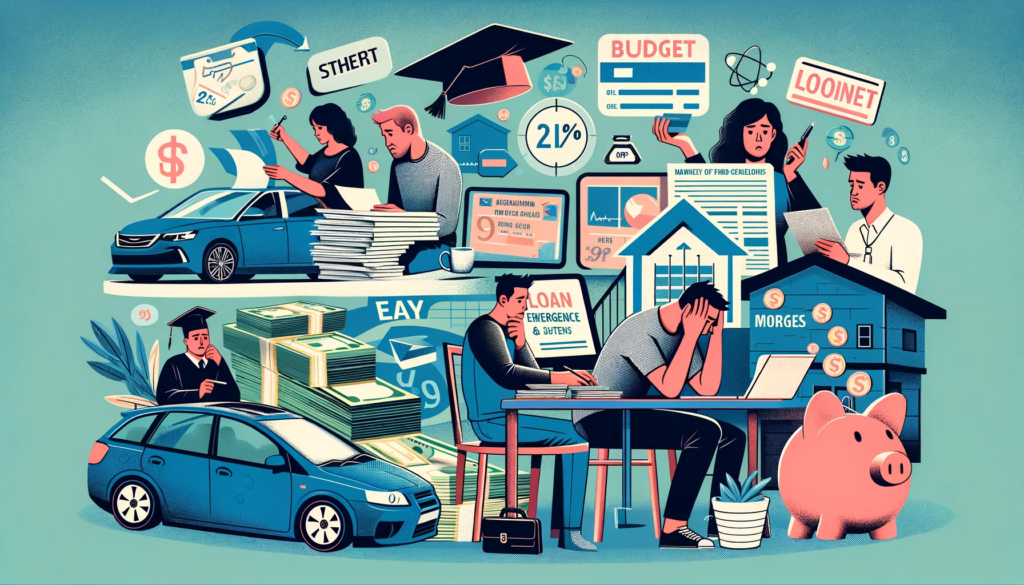Introduction: Navigating Debt in Today’s Economic Landscape
- Current Economic Overview: The U.S. economy is marked by a unique set of challenges, such as rising inflation rates, which have increased the cost of living significantly. For example, as of late 2023, inflation has led to higher prices for essentials like food and gas. Additionally, the Federal Reserve’s response to inflation, primarily through raising interest rates, affects loan and credit card rates.
- The Importance of Debt Management: Effective debt management is essential for financial stability. For instance, a family budgeting to manage a mortgage, car payments, and credit card debt needs to adapt to the changing economic conditions to avoid falling into a debt trap.
Understanding Debt
- Types of Debt:
- Credit Cards: Consider the case of Sarah, who uses her credit card for everyday purchases and only pays the minimum due, leading to growing interest and a ballooning balance.
- Student Loans: John, a recent graduate, faces $30,000 in student debt, a common scenario for many Americans.
- Mortgages: The Smith family has a 30-year fixed mortgage. With current interest rate hikes, those considering new mortgages might face higher monthly payments.
- Auto Loans: Auto loans often have terms of 3-6 years, and like Lisa, who bought a new car, borrowers can find themselves upside down on their loans, owing more than the car’s worth.
- Accumulation of Debt:
- Common issues include using credit cards for emergencies instead of having a savings buffer and taking payday loans with high interest.
- Impact of Debt:
- Debt not only affects financial health but also mental health, as seen in the increasing reports of anxiety and stress related to debt burdens.
Budgeting and Spending Habits
- Creating a Budget:
- Example: Mike earns $3,000 monthly. After tracking expenses, he categorizes and allocates $1,200 for rent, $300 for groceries, $200 for utilities, leaving a remainder for savings and discretionary spending.
- Understanding Cash Flow:
- Tools like Mint or YNAB can help track spending and categorize expenses.
- Smart Spending:
- Consider the 30-day rule for non-essential purchases to avoid impulsive buying.
Saving and Emergency Funds
- Importance of Saving:
- Consistent savings, even $50 a month, can grow over time due to compound interest.
- Building an Emergency Fund:
- Jane, an IT professional, starts by saving $100 per paycheck to build her emergency fund, highlighting the practical approach of starting small.
- Tools for Saving:
- Automating transfers to a savings account can ensure regular savings.
Wise Use of Credit
- Understanding Credit Cards:
- If Tom charges $1,000 on a credit card with an 18% APR and pays only the minimum, it could take years to pay off due to compounding interest.
- Benefits and Risks:
- Credit cards offer rewards and build credit history but can lead to debt if not managed wisely, as seen in Tom’s example.
- Alternatives:
- Using debit cards or cash can help those like Emily, who struggles with impulsive credit card use.
Loans and Borrowing
- Responsible Borrowing:
- Borrow for needs, not wants. For example, taking a loan for a car within your budget instead of a luxury model.
- Types of Loans:
- Personal loans might be useful for debt consolidation, but it’s essential to get favorable terms and rates.
- Interest Rates and Terms:
- Shopping around for a mortgage can save thousands over the loan’s life, as Kevin found when he compared rates from multiple lenders.
Additional Tips and Resources
- Financial Education:
- Regularly reading financial news, books, and attending workshops can increase financial literacy.
- Professional Advice:
- People like Rachel, who experienced overwhelming debt, benefited from consulting a credit counselor.
- Resources:
- Websites like NerdWallet offer comprehensive guides on various financial topics.
Conclusion: Embracing Financial Responsibility
- Recap: Summarize key points – budgeting, emergency funds, wise credit use, and informed borrowing.
- Motivation: Inspire readers to take control of their finances, using examples like Jane’s successful emergency fund or Kevin’s smart mortgage shopping.
Views: 90

